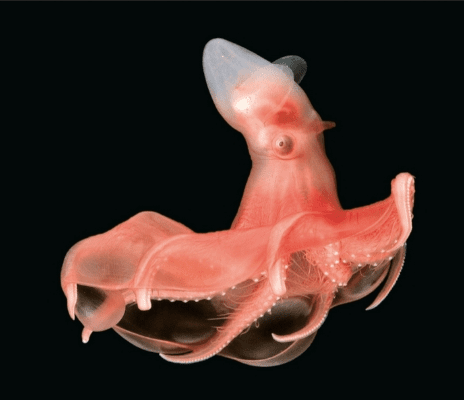Introducing the glowing sucker or bioluminescent octopus, a stunning cephalopod that possesses an extraordinary gift—the power to illuminate its surroundings with an ethereal glow. This elusive marine marvel has baffled researchers for years. Join us in the depths of its bioluminescent world and uncover the secrets and facts behind this remarkable adaptation.
Phylum: Mollusca
Class: Cephalopoda
Order: Octopoda
Family: Stauroteuthidae
Genus: Stauroteuthis
1. It Glows in the Dark
The glowing sucker octopus or bioluminescent octopus is a small species, boasting a mantle length that varies from 2 to 4 inches (5 – 10 cm), while its most extended arm can stretch up to 14 inches (35 cm). This intriguing creature falls under the category of cirrate octopods, known for their distinctive fins employed in swimming.
It’s one of the strangest sea species on Earth. Named for their bioluminescent ability, these octopuses have a remarkable talent for producing light in the darkness. While this trait is widespread among various marine creatures like fish, jellyfish, squids, crustaceans, and cephalopods, it remains exceptionally uncommon among octopuses.

Like other octopus species, glowing sucker octopuses also have suckers under their arms. However, their 45 – 55 suckers do not serve the purpose of adhering to surfaces. Instead, these suckers have evolved to feature photophores, which are organs capable of producing light. When continuously stimulated, these creatures can emit light for approximately 5 minutes. However, as time progresses, the intensity of this light gradually diminishes. The light emanating from the photophores displays a fascinating combination of steady glow and intermittent blinking.
Aligned neatly in a singular row along the arm’s surface, between successive cirri pairs, these photophores emit a mesmerizing blue-green glow. As one moves closer to the arm’s tip, the photophores become progressively sparser, creating an enchanting display of light along the octopus’s arm.

There exist notable distinctions in the shape and arrangement of suckers between the male and female bioluminescent octopuses. In males, the mid-arm suckers are noticeably enlarged, and the first eight are characterized by a barrel-shaped appearance. In contrast, the female individuals showcase smaller suckers that are spread out more. However, both genders do share common features, such as proximal and distal suckers.
In terms of appearance, glowing sucker octopuses exhibit a captivating reddish-brown hue with mesmerizing translucent skin. Like the glass frogs, you can see the octopuses’ inner organs through their skin. Adding to their uniqueness, they possess a U-shaped internal shell, while their eight arms elegantly interlace through secondary webbing, resulting in an enchanting bell-like configuration.
Frequently, these creatures are seen in a bell-like shape, stretching out their arms and spreading their webs.
2. They live in the deep sea
The glowing sucker octopus is a benthopelagic octopus that is often spotted in the depths near the ocean floor. Its natural habitat covers an impressive range, from 500 to 4,000 meters below the surface, with a higher concentration of sightings recorded between 1,500 and 2,500 meters. The depth of its dwelling is strongly associated with the water temperature, as it likes to live in the icy water at approximately 3 – 3.3oC.

They skillfully swim alone in the open sea with their fins. They can also move like jellyfish, propelling themselves by rhythmically expanding and contracting their web, akin to opening and closing an umbrella.
Due to the extreme conditions of its habitat, we can barely see bioluminescent octopuses. Nevertheless, the majority of the species interactions have taken place off the eastern coast of North America’s continental shelf, with a few individuals spotted in the northeastern Atlantic region.
3. Bioluminescent octopus Diet
These bioluminescent octopuses primarily eat small crustaceans, with copepods forming a substantial portion of their diet. Although the precise mechanism of capturing prey remains unclear, it is hypothesized that these species employ their bioluminescence and mucus located around their mouth to get food.
Glowing sucker octopuses employ their bioluminescent glow to entice preys that have sensitive eyes and are easy to drawn toward the mesmerizing light. Instead of relying on their modified suckers to grasp the victims, the light acts as a beacon, coaxing the prey to come closer. Once within range, their bell-shaped web and long cirri deftly ensnare and handle the unsuspecting creatures. Furthermore, the sizeable glands located near their mouths may excrete mucous to ensnare zooplankton effectively.

As these bioluminescent octopuses live within the depths of the ocean, people still don’t know much about their predators as well as their defense mechanism. However, scientists assume that, like other glowing animals, these creatures will produce light to surprise potential threats or lure even greater predators capable of overpowering these enemies.
In response to disturbances, these creatures have the fascinating ability to alter their posture. When disturbed, they fold their arms at the tips while keeping their fins motionless, adopting what is commonly referred to as the “balloon posture.” Another defensive stance they employ, known as the “pumpkin posture,” resembles the balloon posture but on a reduced scale. Whenever they attempt to flee from potential threats, they swiftly revert to the bell posture and strongly move their fins.
4. Reproduction
The life cycle and mating behavior of glowing sucker octopuses continue to hold many secrets, eluding our full understanding.

Researchers have managed to glean some clues about their reproduction, approximating that these intriguing creatures lay approximately 900 eggs in each reproductive cycle, indicating a remarkable level of reproductive capacity.
Yet, even with these valuable findings, the enigmatic aspects of their mating rituals and lifespan remains a mystery.
5. Threats
Because of their deep-sea habitat, these bioluminescent octopuses face minimal risks from human-induced dangers like climate change and pollution. However, their safety is not absolute. Surprisingly, numerous studies have revealed that their delicate gelatinous bodies frequently suffer harm due to trawling and collecting activities.
References:

